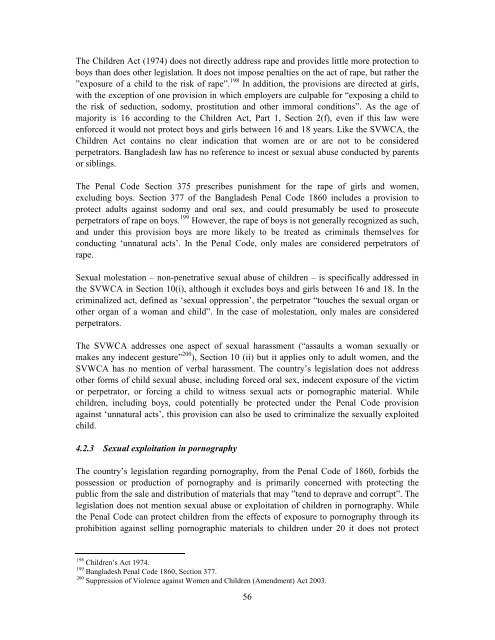SEXUAL ABUSE AND EXPLOITATION OF BOYS IN SOUTH ASIA A ...
SEXUAL ABUSE AND EXPLOITATION OF BOYS IN SOUTH ASIA A ...
SEXUAL ABUSE AND EXPLOITATION OF BOYS IN SOUTH ASIA A ...
Create successful ePaper yourself
Turn your PDF publications into a flip-book with our unique Google optimized e-Paper software.
The Children Act (1974) does not directly address rape and provides little more protection to<br />
boys than does other legislation. It does not impose penalties on the act of rape, but rather the<br />
”exposure of a child to the risk of rape”. 198 In addition, the provisions are directed at girls,<br />
with the exception of one provision in which employers are culpable for “exposing a child to<br />
the risk of seduction, sodomy, prostitution and other immoral conditions”. As the age of<br />
majority is 16 according to the Children Act, Part 1, Section 2(f), even if this law were<br />
enforced it would not protect boys and girls between 16 and 18 years. Like the SVWCA, the<br />
Children Act contains no clear indication that women are or are not to be considered<br />
perpetrators. Bangladesh law has no reference to incest or sexual abuse conducted by parents<br />
or siblings.<br />
The Penal Code Section 375 prescribes punishment for the rape of girls and women,<br />
excluding boys. Section 377 of the Bangladesh Penal Code 1860 includes a provision to<br />
protect adults against sodomy and oral sex, and could presumably be used to prosecute<br />
perpetrators of rape on boys. 199 However, the rape of boys is not generally recognized as such,<br />
and under this provision boys are more likely to be treated as criminals themselves for<br />
conducting ‘unnatural acts’. In the Penal Code, only males are considered perpetrators of<br />
rape.<br />
Sexual molestation – non-penetrative sexual abuse of children – is specifically addressed in<br />
the SVWCA in Section 10(i), although it excludes boys and girls between 16 and 18. In the<br />
criminalized act, defined as ‘sexual oppression’, the perpetrator “touches the sexual organ or<br />
other organ of a woman and child”. In the case of molestation, only males are considered<br />
perpetrators.<br />
The SVWCA addresses one aspect of sexual harassment (“assaults a woman sexually or<br />
makes any indecent gesture” 200 ), Section 10 (ii) but it applies only to adult women, and the<br />
SVWCA has no mention of verbal harassment. The country’s legislation does not address<br />
other forms of child sexual abuse, including forced oral sex, indecent exposure of the victim<br />
or perpetrator, or forcing a child to witness sexual acts or pornographic material. While<br />
children, including boys, could potentially be protected under the Penal Code provision<br />
against ‘unnatural acts’, this provision can also be used to criminalize the sexually exploited<br />
child.<br />
4.2.3 Sexual exploitation in pornography<br />
The country’s legislation regarding pornography, from the Penal Code of 1860, forbids the<br />
possession or production of pornography and is primarily concerned with protecting the<br />
public from the sale and distribution of materials that may ”tend to deprave and corrupt”. The<br />
legislation does not mention sexual abuse or exploitation of children in pornography. While<br />
the Penal Code can protect children from the effects of exposure to pornography through its<br />
prohibition against selling pornographic materials to children under 20 it does not protect<br />
198 Children’s Act 1974.<br />
199 Bangladesh Penal Code 1860, Section 377.<br />
200 Suppression of Violence against Women and Children (Amendment) Act 2003.<br />
56










